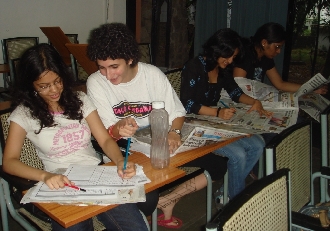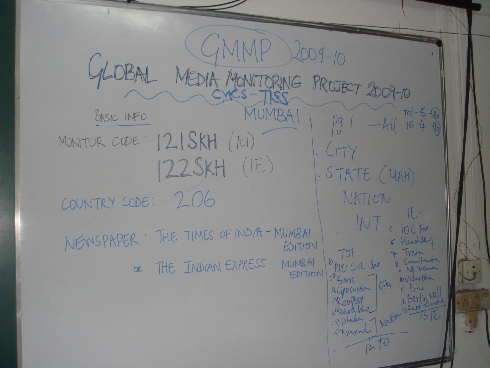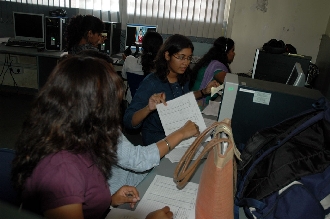As representatives of the 45 nations (including India) that are currently members of the United Nations Commission on the Status of Women settle into their seats for the 54th session of the Commission which began in New York on 1 March, they will no doubt be inundated with information and analyses to help them in the task ahead: a review of the follow-up to the Beijing Declaration and Platform for Action adopted 15 years ago by the Fourth World Conference on Women, as well as a subsequent document, Women 2000: Gender equality, development and peace for the 21st Century, which emerged from the 23rd special session of the UN General Assembly.
Among the 12 critical areas of concern listed in the 1995 Beijing documents is Women and the Media, elaborated upon in Section J of the Platform for Action. The preliminary report of the fourth Global Media Monitoring Project (GMMP 2009-2010), the worlds largest and longest-running longitudinal research and action initiative on gender in the news media, released in New York on 2 March (Day 2 of the ongoing CSW session), is expected to provide delegates with useful inputs as they begin to evaluate progress in the implementation of the strategic objectives outlined in Section J.

![]() Students at the Tata Institute of Social Sciences, Mumbai, participating in the GMMP monitoring.
Students at the Tata Institute of Social Sciences, Mumbai, participating in the GMMP monitoring.
The overarching purpose of the GMMP, coordinated by the Canada-based World Association for Christian Communication (WACC), is to promote fair and balanced gender representation in and through the news media on the basis of information and insights gathered through systematic, periodic media monitoring. The GMMP research process is unique in involving participants ranging from grassroots community organisations to university students and researchers to media practitioners, all of whom participate in the monitoring on a voluntary basis.
On Tuesday, 10 November 2009, volunteers in 130 countries across the world, including India, spent much of the day poring over national newspapers, listening to radio newscasts and watching television news (the research design included online media only in certain selected countries; India was not one of them). As GMMP monitors, they were engaged in observing and analysing the days news and recording their findings on a number of selected indicators.
The new, preliminary report on the findings of the 4th GMMP provides a snapshot of the representation and portrayal of women and men in news media around the world, based on a sample of 42 out of the 130 participating countries. The findings in the report are based on an analysis of 6,902 news items containing 14,044 news subjects, including people interviewed for/about the news, in 42 countries spread across Africa, Asia, Latin America, the Caribbean region, the Pacific Islands and Europe.
The report includes data gathered through the monitoring process in India. Significantly, the data for North America was not available for inclusion in the preliminary report. The complete, definitive results of the 4th GMMP will be presented in the final report, expected to be published in September 2010.
As the report points out, The hierarchy of priorities revealed in the distribution of stories across the major topics suggests the need for a radical transformation of the news media agenda towards one that is more gender-aware and gender-responsive. This means a rethinking of the order of priorities to achieve an agenda in which issues of particular concern to women are elevated from a subordinate status to one that affirms the importance of such issues to 52 percent of the population. The 12 critical areas in the Beijing Platform for Action provide direction on some issues of primary concern to women.
The GMMP in India
On monitoring day (10 November 2009) the front pages of most national newspapers across India were dominated by the unseemly spectacle in the Legislative Assembly of Maharashtra, where four MLAs assaulted a colleague from another party for taking his oath in Hindi rather than in Marathi. Several newspapers also carried news of the chaos in the High Court of Karnataka, where lawyers were agitating against the Chief Justice who had been accused of corruption (in the form of acquisition of land in another state through unfair means).
 A media monitoring session at the Tata Institute of Social Sciences, Mumbai.
A media monitoring session at the Tata Institute of Social Sciences, Mumbai.
The ongoing troubles of the government of Karnataka, with the widening fissures in the ruling party, also claimed space on many front pages. The release of The India Gender Gap Review 2009 produced by the World Economic Summit found some space on some front pages. In several places, television and radio news was over-run by the results of local by-elections.
The original sample selected by GMMP volunteers in different parts of the country comprised 26 daily newspapers in 10 Indian languages (including English), 12 TV news channels in 6 languages, and 6 radio news bulletins in 4 languages aired by different stations of All India Radio (the only radio broadcaster in the country currently allowed to disseminate news and current affairs). The attempt was to ensure that a cross-section of media in different parts of the country in different languages was monitored so that the sample was as representative as possible of the diversity and plurality of the Indian media.
However, some volunteers fell by the wayside and others submitted coding sheets that could not be used so the final sample was smaller: 20 dailies, 11 TV news bulletins, and 5 radio bulletins. The print media covered included newspapers in English, Hindi, Marathi, Gujarati, Kannada, Telugu, Malayalam, Oriya and Tamil; the TV sample included private news channels as well as Doordarshan in English, Hindi, Kannada, Telugu and Malayalam; radio was represented by AIR bulletins in English, Hindi, Marathi, Telugu and Malayalam.
Approximately 22 monitors finally participated in the monitoring exercise on 10 November (down from close to 60 volunteers in the initial stages of the process). However, the number of persons actually involved with the GMMP monitoring in India is higher since several volunteers involved students in the monitoring. Among the volunteers, about 14 monitored only newspapers and two monitored only television news while the remaining did a combination of all three media forms.
The latest edition of the GMMP has revealed that less than a quarter (24 percent) of the people heard, seen or read about in mainstream broadcast and print news worldwide is female. This represents just a 7 percent increase in 15 years: the first GMMP report in 1995 recorded that only 17 percent of the people in the news were women. As an editorial in Daily Links, a newspaper being produced by the South Africa-based Gender Links during the CSW session in New York, points out, "...if we are to continue to progress at this rate it will take at least another century before parity is achieved." The increase in women as news subjects was even smaller in topics that rank high on the agenda of the news media 4 percent in stories on politics & government and just 1 percent in stories on the economy.
To make matters worse, a significant component of the 3 percent increase in women in the news between 2005 and 2010 is apparently due to the notable increase in women as providers of popular opinion, rather than as experts. As persons interviewed in the news, women are concentrated in the categories of ordinary interviewees in contrast to men, who are concentrated in the expert categories. Women have achieved near parity among those supposedly reflecting the view of ordinary citizens in news stories (47 percent female, 53 percent male). However, they continue to be under-represented as experts providing comment based on specialist knowledge or experience (19 percent) and spokespersons speaking on behalf of organisations (18 percent). In other words, less than one out of every five authoritative sources interviewed by news media is female.
The latest round of GMMP monitoring found some improvement in the ratio of women to men who are central in news stories, with 16 percent of all stories focusing specifically on women. This marks an overall increase from the 10 percent recorded in the 2005 report. The top topics in which women are central pertain to women and politics, violence and crime. There seems to be a significant increase in women-centred stories in the area of politics/government (from 8 percent in 2005 to 18 percent in 2010) and a marginal improvement in news relating to the economy (from 3 percent of stories in 2005 to 7 percent in 2010).
Nevertheless, the percentage of stories in which women are not central far outweighs the percentage of those in which they are. In addition, the preliminary results show that women are not at all central in several news topics that are of vital importance to them, such as labour (employment, unemployment) and poverty (housing, social welfare, financial assistance/aid).
As the report points out, While increased general visibility of women is desirable, it is even more crucial for womens presence in every area to be reflected in the news. Such news then would achieve a more realistic picture of the world.
It appears that women are still five times as likely as men to be portrayed in their roles as wives, mothers, and so on: 19 percent of women appearing in the news are identified by their family status while only 4 percent of men in the news are described in that way. Similarly, with regard to the occupations of news subjects, the categories in which women make it over the 50 percent mark are home-maker/parent and student/pupil/school child.
The next few categories in which women are reasonably well-represented (just below 50 percent) are: villager or resident engaged in unspecified occupation; office or service worker/non-management worker in office, store, restaurant/catering; and unemployed. The only other categories in which women make a respectable showing are: celebrity, artist, actor, writer, singer, radio or television personality; and child, young person (below 18 years).
According to the preliminary report of the GMMP 2010, The picture painted through the news on the occupations of news subjects is discordant with the reality. The news presents a world in which men outnumber women in almost all occupational categories, with the highest disparity being in the professions for instance, health (62 percent are men), legal (83 percent), science (80 percent) and government (83 percent). In reality, womens share in all professions is much higher than depicted. The news presents a skewed picture of a world in which women are almost absent in positions of authority or responsibility outside the home.

![]() Students at the Indian Institute of Journalism and New Media, Bangalore, participating in the GMMP monitoring.
Students at the Indian Institute of Journalism and New Media, Bangalore, participating in the GMMP monitoring.
The report also provides a picture of womens participation and contribution as media professionals. The preliminary results indicate that the percentage of stories by female reporters has increased since 2005 in print (to 35 percent) and news television (to 44 percent) but decreased in radio newscasts (27 percent). However, the percentage of stories by male reporters continues to surpass that by female reporters in all three media forms.
The preliminary results indicate that news, in general, continues to be overwhelmingly reported by men, while news in the so-called soft areas of coverage (arts, entertainment and lifestyle) are more likely to be reported by women. However, there appears to be a rise in the percentage of stories reported by women in the areas of crime and violence, media and sports, and social and legal issues, besides celebrity-related news.
The preliminary results also reveal that news stories by female reporters tend to have more female news subjects than stories by male reporters: while women make up over a quarter (26 percent) of news subjects in stories by female journalists, they constitute less than a fifth (19 percent) of news subjects in stories by male journalists. The results also suggest that news stories by female reporters are almost twice as likely to challenge gender stereotypes as stories by male reporters (11 percent by the former compared to 6 percent by the latter).
However, the difference between male and female media professionals in this respect seems less significant than a related fact uncovered by the monitoring. According to the preliminary report of the GMMP, almost one half (48 percent) of all news stories reinforce gender stereotypes, while only 8 percent challenge such stereotypes. In other words, ten years into the new millennium, news stories are six times more likely to reinforce gender stereotypes than to challenge them.
What is more, only 12 percent of news stories were found to highlight issues of gender equality or inequality. The good news is that the percentage of stories that shed light on an aspect of gender equality or inequality has tripled in the last five years. The bad news is that stories that miss the opportunity to highlight such issues are still by far more numerous.
The latest round of the GMMP also reveals that only 9 percent of news stories mention gender equality policies or human and womens rights legal instruments. According to the preliminary report, This finding suggests that numerous stories miss the opportunity to create awareness on instruments enacted to protect human rights, womens rights or gender equality. The finding also supports an observation by gender and communication groups that human rights, and in particular womens human rights, are relatively invisible in mainstream media coverage.
Since this edition of the GMMP was partly designed to coincide with the 15-year review of progress in acting upon the recommendations in the Beijing Platform for Action, it sought to highlight selected issues listed as critical areas of concern in the document, such as poverty, gender-based violence, peace, women & economic participation, and women & politics.
According to the preliminary report, all but one of the selected topics receive an average total of less than 1.5 percent of news media coverage across the three media forms: of the stories that appeared in the news during the monitoring day, 1.3 percent were on gender-based violence, 0.3 percent on womens economic participation, 1.2 percent on poverty and 0.9 percent on peace. Issues related to womens political participation fared better, receiving 3.4 percent of media attention. The print media provided the most amount of coverage on all five selected themes.
For more information about the GMMP and the full text of the preliminary report, visit the Who Makes the News website.

